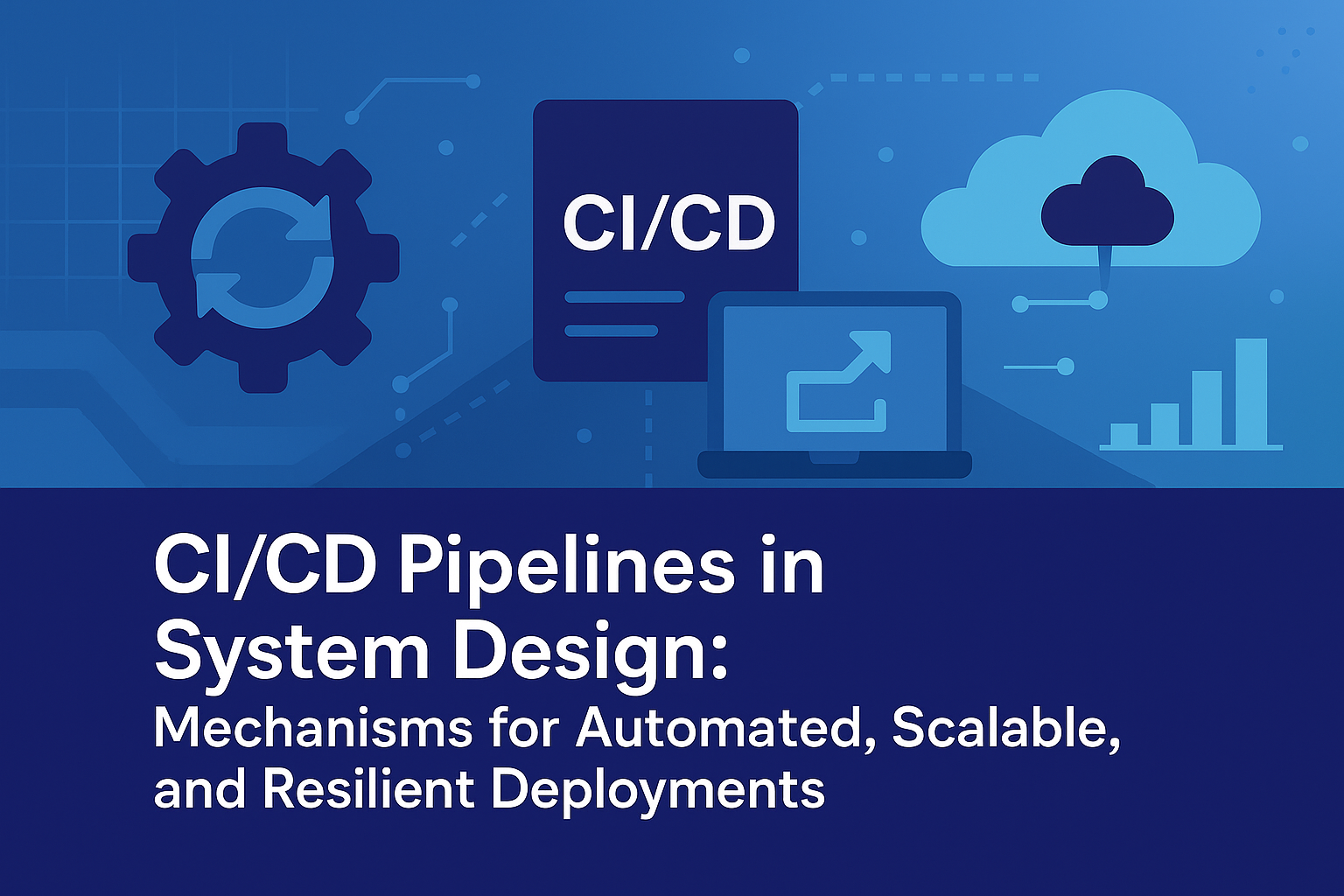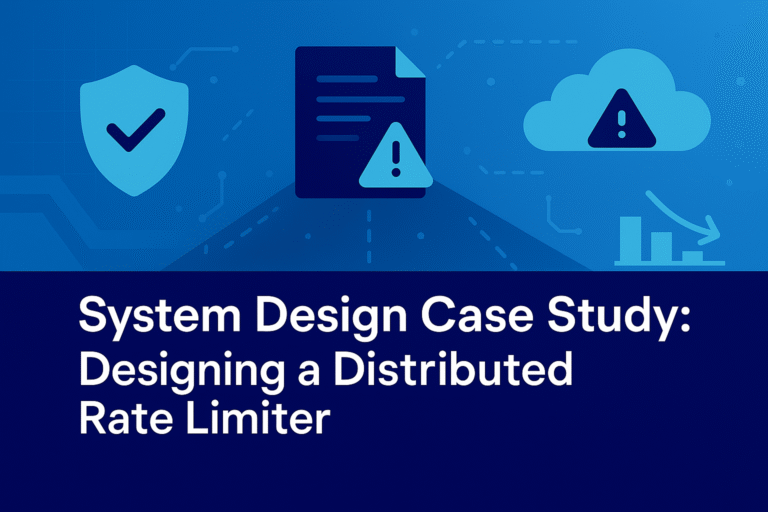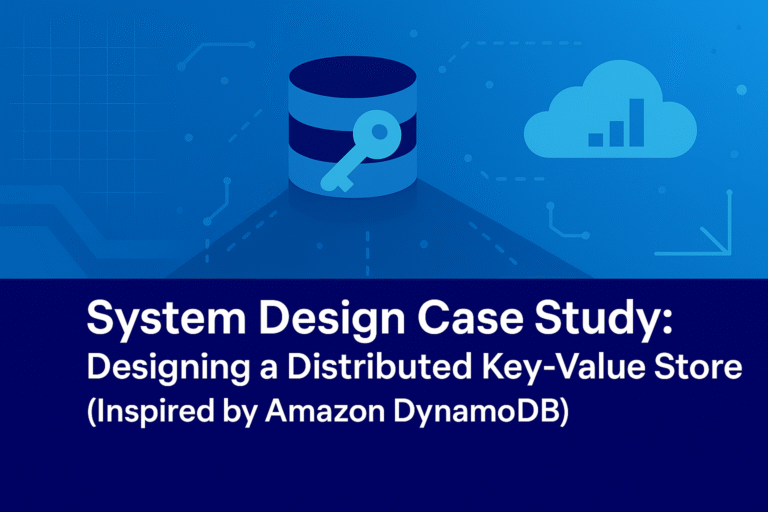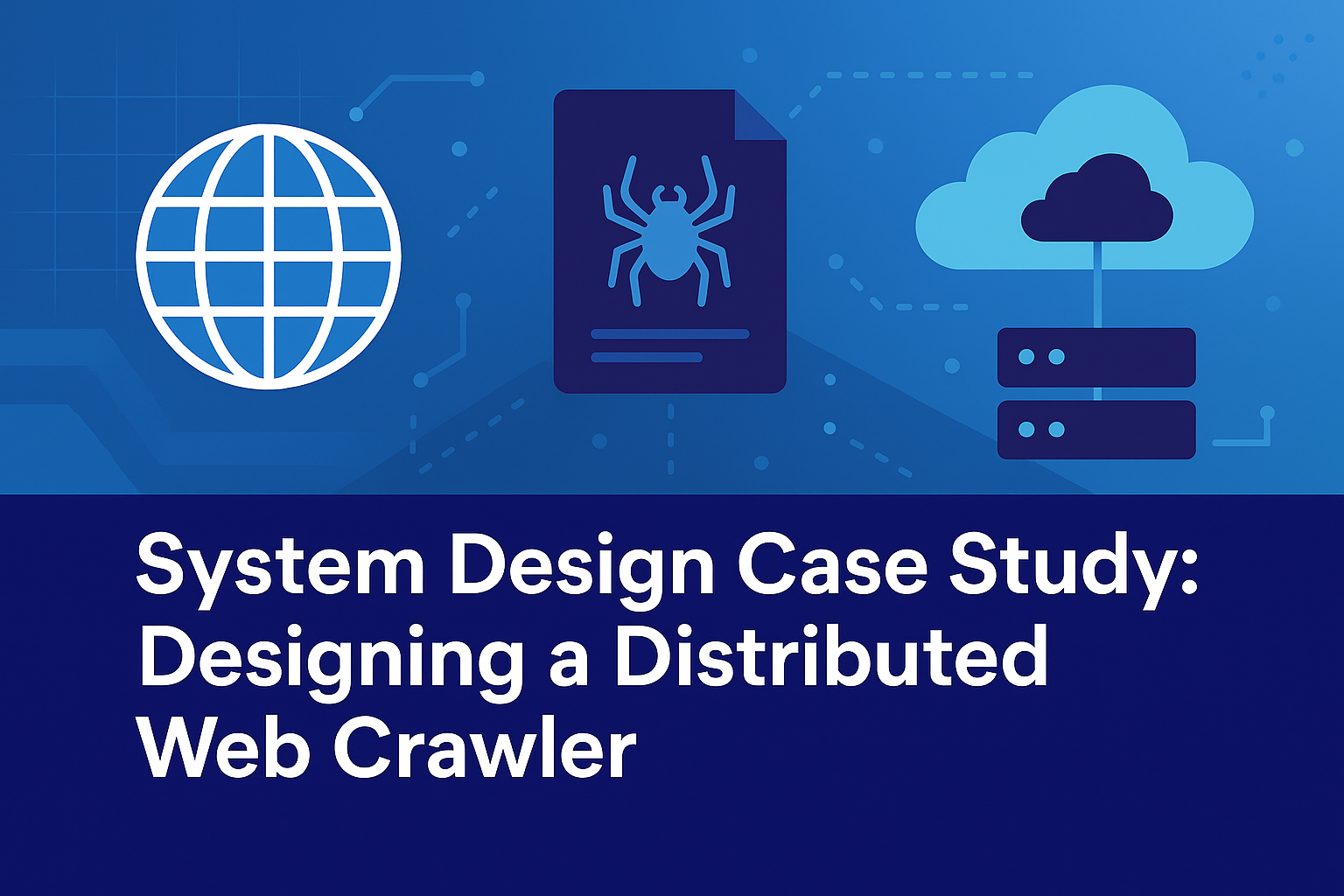Introduction
Continuous Integration and Continuous Deployment (CI/CD) pipelines are critical components of modern system design, enabling automated, reliable, and rapid delivery of software in distributed systems. CI/CD pipelines streamline the process of building, testing, and deploying applications, ensuring high availability (e.g., 99.999% uptime), scalability (e.g., 1M req/s), and resilience for cloud-native applications like e-commerce platforms, financial systems, and IoT solutions. By automating repetitive tasks and enforcing best practices, CI/CD pipelines reduce deployment errors, accelerate release cycles, and support cloud-native design. This comprehensive analysis details the architecture, mechanisms, implementation strategies, advantages, limitations, and trade-offs of CI/CD pipelines in system design, with C# code examples as per your preference. It integrates foundational distributed systems concepts from your prior conversations, including the CAP Theorem, consistency models, consistent hashing, idempotency, unique IDs (e.g., Snowflake), heartbeats, failure handling, single points of failure (SPOFs), checksums, GeoHashing, rate limiting, Change Data Capture (CDC), load balancing, quorum consensus, multi-region deployments, capacity planning, backpressure handling, exactly-once vs. at-least-once semantics, event-driven architecture (EDA), microservices design, inter-service communication, data consistency, deployment strategies, testing strategies, Domain-Driven Design (DDD), API Gateway, Saga Pattern, Strangler Fig Pattern, Sidecar/Ambassador/Adapter Patterns, Resiliency Patterns, Service Mesh, Micro Frontends, API Versioning, Cloud-Native Design, Cloud Service Models, Containers vs. VMs, Kubernetes Architecture & Scaling, Serverless Architecture, and 12-Factor App Principles. Drawing on your interest in e-commerce integrations, API scalability, and resilient systems, this guide provides a structured framework for architects to design and implement CI/CD pipelines that align with business needs for rapid iteration, reliability, and scalability.
Core Principles of CI/CD Pipelines
CI/CD pipelines automate the software delivery process, from code changes to production deployment, ensuring consistent, repeatable, and error-free releases. Continuous Integration (CI) focuses on frequently integrating code changes, running automated tests, and producing artifacts. Continuous Deployment (CD) extends CI by automatically deploying validated changes to production environments.
- Key Principles:
- Automation: Automate build, test, and deployment tasks to reduce manual errors (e.g., 90% fewer deployment issues).
- Frequent Integration: Merge code changes multiple times daily, validated by automated tests.
- Fast Feedback: Provide immediate feedback on code quality (e.g., test results in < 5min).
- Reliable Deployments: Use deployment strategies (e.g., Blue-Green, Canary) for zero-downtime releases.
- Scalability: Support high-throughput systems (e.g., 1M req/s) with automated scaling.
- Resilience: Incorporate resiliency patterns (e.g., retries, circuit breakers) in deployment workflows.
- Observability: Monitor pipeline performance and application metrics (e.g., latency < 15ms, errors < 0.1%).
- Mathematical Foundation:
- Build Time: Total Build Time = compile_time + test_time + artifact_time, e.g., 2min + 3min + 1min = 6min.
- Deployment Frequency: Frequency = commits_per_day ÷ pipeline_duration, e.g., 10 commits/day ÷ 6min = 100 deploys/day.
- Error Rate: Error Rate = failed_deploys / total_deploys, e.g., 1/100 = 1%.
- Availability: Availability = 1 − (downtime_per_deploy × deploys_per_day), e.g., 99.999% with 1s downtime × 10 deploys.
- Integration with Prior Concepts:
- CAP Theorem: Prioritizes AP for availability in deployments, as per your CAP query.
- Consistency Models: Uses eventual consistency via CDC/EDA, as per your data consistency query.
- Consistent Hashing: Routes traffic during deployments, as per your load balancing query.
- Idempotency: Ensures safe retries in pipelines, as per your idempotency query.
- Failure Handling: Uses circuit breakers, retries, timeouts, DLQs, as per your Resiliency Patterns query.
- Heartbeats: Monitors pipeline health (< 5s), as per your heartbeats query.
- SPOFs: Avoids via distributed pipeline runners, as per your SPOFs query.
- Checksums: Verifies artifacts (SHA-256), as per your checksums query.
- GeoHashing: Routes traffic by region during deployments, as per your GeoHashing query.
- Rate Limiting: Caps deployment traffic (100,000 req/s), as per your rate limiting query.
- CDC: Syncs data during migrations, as per your data consistency query.
- Load Balancing: Distributes traffic post-deployment, as per your load balancing query.
- Multi-Region: Reduces latency (< 50ms) in global deployments, as per your multi-region query.
- Backpressure: Manages pipeline load, as per your backpressure query.
- EDA: Triggers pipelines via events, as per your EDA query.
- Saga Pattern: Coordinates multi-service deployments, as per your Saga query.
- DDD: Aligns pipelines with Bounded Contexts, as per your DDD query.
- API Gateway: Routes traffic post-deployment, as per your API Gateway query.
- Strangler Fig: Supports incremental migrations, as per your Strangler Fig query.
- Service Mesh: Manages inter-service communication post-deployment, as per your Service Mesh query.
- Micro Frontends: Deploys front-end components, as per your Micro Frontends query.
- API Versioning: Manages API changes, as per your API Versioning query.
- Cloud-Native Design: Core to CI/CD, as per your Cloud-Native Design query.
- Cloud Service Models: Aligns with PaaS/FaaS, as per your Cloud Service Models query.
- Containers vs. VMs: Uses containers for builds, as per your Containers vs. VMs query.
- Kubernetes: Deploys to Kubernetes clusters, as per your Kubernetes query.
- Serverless: Deploys serverless functions, as per your Serverless query.
- 12-Factor App: Implements build/release/run and config principles, as per your 12-Factor query.
CI/CD Pipeline Architecture
A CI/CD pipeline consists of stages that transform code changes into production deployments, orchestrated by tools like GitHub Actions, Jenkins, GitLab CI/CD, or Azure DevOps.
Key Components
- Source Control:
- Repository (e.g., GitHub) stores the codebase, adhering to 12-Factor Codebase.
- Triggers pipelines on code commits or pull requests.
- Build Stage:
- Compiles code, resolves dependencies (e.g., NuGet for C#), and produces artifacts (e.g., Docker images).
- Uses 12-Factor Dependencies for isolation.
- Test Stage:
- Runs unit, integration, and contract tests to validate code quality.
- Aligns with testing strategies, as per your testing query.
- Artifact Repository:
- Stores build artifacts (e.g., Docker images in Amazon ECR, Azure Container Registry).
- Uses checksums (SHA-256) for integrity, as per your checksums query.
- Deployment Stage:
- Deploys artifacts to environments (e.g., Kubernetes, AWS Lambda).
- Uses deployment strategies (Blue-Green, Canary), as per your deployment query.
- Monitoring and Observability:
- Tracks pipeline performance (e.g., build time < 6min) and application metrics (e.g., latency < 15ms).
- Uses Prometheus, Jaeger, and CloudWatch, as per your Kubernetes and Serverless queries.
- Secrets Management:
- Stores sensitive data (e.g., API keys) in tools like AWS Secrets Manager or HashiCorp Vault.
- Aligns with 12-Factor Config.
Workflow
- Code Commit:
- Developer pushes code to GitHub, triggering the pipeline.
- Build:
- Compile C# code, build Docker images, and push to ECR.
- Test:
- Run xUnit unit tests, Testcontainers integration tests, and Pact contract tests.
- Artifact Storage:
- Store Docker images with checksums for verification.
- Deploy:
- Deploy to Kubernetes (Blue-Green) or AWS Lambda (Canary).
- Use Service Mesh for traffic routing, as per your Service Mesh query.
- Monitor:
- Track deployment success, application metrics (latency < 15ms, errors < 0.1%).
- Alert on failures via CloudWatch.
CI/CD Mechanisms
1. Continuous Integration (CI)
- Mechanism:
- Automatically build and test code on every commit or pull request.
- Use parallel jobs to reduce build time (e.g., 6min for 1,000 tests).
- Validate code quality with linters, unit tests, and code coverage (> 80%).
- Implementation:
- GitHub Actions workflow to build C# projects and run xUnit tests.
- Parallelize tests across multiple runners.
- Applications:
- Ensures code quality for microservices (e.g., Order Service).
- Reduces integration bugs (90% fewer issues).
2. Continuous Deployment (CD)
- Mechanism:
- Automatically deploy validated artifacts to production or staging.
- Use deployment strategies (Blue-Green, Canary) for zero-downtime releases.
- Roll back on failures using idempotency and versioning.
- Implementation:
- Deploy Docker images to Kubernetes with Helm charts.
- Use AWS SAM for serverless deployments.
- Applications:
- Enables frequent releases (e.g., 10 deploys/day) for e-commerce.
- Supports Strangler Fig migrations, as per your Strangler Fig query.
3. Deployment Strategies
- Blue-Green:
- Run two identical environments (Blue, Green); switch traffic after validation.
- Ensures zero downtime, aligns with 12-Factor Disposability.
- Canary:
- Gradually roll out changes to a subset of users (e.g., 5% traffic).
- Reduces risk, uses GeoHashing for regional routing, as per your GeoHashing query.
- Rolling Updates:
- Incrementally update instances in Kubernetes.
- Balances speed and stability.
4. Observability and Feedback
- Mechanism:
- Monitor pipeline metrics (build time, success rate) and application SLIs (latency, throughput, errors).
- Use heartbeats (< 5s) for health checks, as per your heartbeats query.
- Alert on anomalies (> 0.1% errors) via CloudWatch.
- Implementation:
- Prometheus for pipeline metrics, Jaeger for tracing, Fluentd for logs.
- Integrate with 12-Factor Logs.
5. Resilience in Pipelines
- Mechanism:
- Implement retries, timeouts, and circuit breakers for pipeline steps.
- Use DLQs for failed deployments, as per your failure handling query.
- Ensure idempotent operations with Snowflake IDs, as per your idempotency query.
- Implementation:
- Retry failed tests or deployments (3 attempts, 100ms backoff).
- Store failed events in SQS DLQs.
Detailed Analysis
Advantages
- Automation: Reduces manual errors (90% fewer deployment issues).
- Speed: Accelerates release cycles (e.g., 10 deploys/day).
- Scalability: Supports high-throughput systems (1M req/s) with automated scaling.
- Resilience: Ensures zero-downtime deployments with Blue-Green/Canary strategies.
- Observability: Provides fast feedback (test results in < 5min) with Prometheus/Jaeger.
- Portability: Works across clouds (AWS, Azure, GCP) with containers.
Limitations
- Complexity: Requires expertise in CI/CD tools and orchestration (e.g., Kubernetes).
- Cost: Pipeline runners and observability tools increase costs (e.g., $0.10/build).
- Setup Time: Initial pipeline configuration can take weeks.
- Dependency Management: Requires robust dependency isolation, as per 12-Factor Dependencies.
Trade-Offs
- Speed vs. Stability:
- Trade-Off: Frequent deployments (10/day) enable rapid iteration but risk errors.
- Decision: Use Canary deployments for high-traffic apps, Blue-Green for critical systems.
- Interview Strategy: Propose Canary for e-commerce, Blue-Green for banking.
- Automation vs. Cost:
- Trade-Off: Automation reduces errors but increases cloud costs.
- Decision: Use CI/CD for production apps, manual processes for prototypes.
- Interview Strategy: Highlight CI/CD for Netflix-scale apps, manual for startups.
- Complexity vs. Flexibility:
- Trade-Off: CI/CD pipelines enable scalability but add setup complexity.
- Decision: Use CI/CD for microservices, simpler tools for monolithic apps.
- Interview Strategy: Propose CI/CD for distributed systems, PaaS for small apps.
- Consistency vs. Availability:
- Trade-Off: Eventual consistency via EDA ensures availability, as per your CAP query.
- Decision: Use EDA for non-critical data, strong consistency for critical.
- Interview Strategy: Propose EDA for e-commerce, strong consistency for finance.
Integration with Prior Concepts
- CAP Theorem: Prioritizes AP, as per your CAP query.
- Consistency Models: Uses eventual consistency via CDC/EDA, as per your data consistency query.
- Consistent Hashing: Routes traffic post-deployment, as per your load balancing query.
- Idempotency: Ensures safe retries, as per your idempotency query.
- Failure Handling: Uses circuit breakers, retries, timeouts, DLQs, as per your Resiliency Patterns query.
- Heartbeats: Monitors pipeline health (< 5s), as per your heartbeats query.
- SPOFs: Avoids via distributed runners, as per your SPOFs query.
- Checksums: Verifies artifacts (SHA-256), as per your checksums query.
- GeoHashing: Routes traffic by region, as per your GeoHashing query.
- Rate Limiting: Caps deployment traffic (100,000 req/s), as per your rate limiting query.
- CDC: Syncs data during migrations, as per your data consistency query.
- Load Balancing: Distributes traffic post-deployment, as per your load balancing query.
- Multi-Region: Reduces latency (< 50ms), as per your multi-region query.
- Backpressure: Manages pipeline load, as per your backpressure query.
- EDA: Triggers pipelines, as per your EDA query.
- Saga Pattern: Coordinates multi-service deployments, as per your Saga query.
- DDD: Aligns pipelines with Bounded Contexts, as per your DDD query.
- API Gateway: Routes traffic post-deployment, as per your API Gateway query.
- Strangler Fig: Supports incremental migrations, as per your Strangler Fig query.
- Service Mesh: Manages communication post-deployment, as per your Service Mesh query.
- Micro Frontends: Deploys front-end components, as per your Micro Frontends query.
- API Versioning: Manages API changes, as per your API Versioning query.
- Cloud-Native Design: Core to CI/CD, as per your Cloud-Native Design query.
- Cloud Service Models: Aligns with PaaS/FaaS, as per your Cloud Service Models query.
- Containers vs. VMs: Uses containers for builds, as per your Containers vs. VMs query.
- Kubernetes: Deploys to clusters, as per your Kubernetes query.
- Serverless: Deploys functions, as per your Serverless query.
- 12-Factor App: Implements build/release/run, config, and logs, as per your 12-Factor query.
Real-World Use Cases
1. E-Commerce Platform
- Context: An e-commerce platform (e.g., Shopify integration, as per your query) processes 100,000 orders/day, needing frequent updates and zero-downtime deployments.
- Implementation:
- Pipeline: GitHub Actions builds Docker images, runs xUnit tests, and deploys to Kubernetes.
- Stages: Build (2min), test (3min), deploy (Blue-Green, 1min).
- Resiliency: Retries failed deployments (3 attempts), DLQs for failed events.
- Observability: Prometheus for pipeline metrics, Jaeger for tracing.
- Deployment: Kubernetes with Service Mesh (Istio) for consistent hashing.
- EDA: Kafka for order events, CDC for data sync.
- Micro Frontends: React-based UI, as per your Micro Frontends query.
- Metrics: < 15ms latency, 100,000 req/s, 99.999% uptime, 10 deploys/day.
- Trade-Off: Speed with pipeline complexity.
- Strategic Value: Enables rapid feature releases for sales events.
2. Financial Transaction System
- Context: A banking system processes 500,000 transactions/day, requiring reliability, as per your tagging system query.
- Implementation:
- Pipeline: Azure DevOps builds C# artifacts, runs tests, and deploys to Azure Kubernetes Service (AKS).
- Stages: Build (3min), test (4min), deploy (Canary, 2min).
- Resiliency: Circuit breakers for deployment failures, Saga Pattern for coordination.
- Observability: Application Insights for metrics/tracing.
- Deployment: AKS with API Gateway for routing.
- Metrics: < 20ms latency, 10,000 tx/s, 99.99% uptime, 5 deploys/day.
- Trade-Off: Reliability with setup complexity.
- Strategic Value: Ensures compliant and reliable deployments.
3. IoT Sensor Platform
- Context: A smart city processes 1M sensor readings/s, needing rapid scaling, as per your EDA query.
- Implementation:
- Pipeline: GitHub Actions builds serverless functions, tests with Testcontainers, and deploys to AWS Lambda.
- Stages: Build (1min), test (2min), deploy (Canary, 30s).
- Resiliency: Managed retries, DLQs (SQS).
- Observability: CloudWatch for metrics, X-Ray for tracing.
- Deployment: Lambda with GeoHashing for regional routing.
- EDA: Kafka for data ingestion.
- Micro Frontends: Svelte-based dashboard, as per your Micro Frontends query.
- Metrics: < 110ms latency (incl. cold starts), 1M req/s, 99.999% uptime, 20 deploys/day.
- Trade-Off: Scalability with cold start latency.
- Strategic Value: Supports real-time analytics with frequent updates.
Implementation Guide
// Order Service (CI/CD-Ready)
using Confluent.Kafka;
using Microsoft.AspNetCore.Mvc;
using Polly;
using Serilog;
using System.Net.Http;
namespace OrderContext
{
[ApiController]
[Route("v1/orders")]
public class OrderController : ControllerBase
{
private readonly IHttpClientFactory _clientFactory;
private readonly IProducer<Null, string> _kafkaProducer;
private readonly IAsyncPolicy<HttpResponseMessage> _resiliencyPolicy;
public OrderController(IHttpClientFactory clientFactory, IProducer<Null, string> kafkaProducer)
{
_clientFactory = clientFactory;
_kafkaProducer = kafkaProducer;
// Resiliency: Circuit Breaker, Retry, Timeout
_resiliencyPolicy = Policy.WrapAsync(
Policy<HttpResponseMessage>
.HandleTransientHttpError()
.CircuitBreakerAsync(5, TimeSpan.FromSeconds(30)),
Policy<HttpResponseMessage>
.HandleTransientHttpError()
.WaitAndRetryAsync(3, retryAttempt => TimeSpan.FromMilliseconds(100 * Math.Pow(2, retryAttempt))),
Policy.TimeoutAsync<HttpResponseMessage>(TimeSpan.FromMilliseconds(500))
);
// Logs to stdout (12-Factor Logs)
Log.Logger = new LoggerConfiguration()
.WriteTo.Console()
.CreateLogger();
}
[HttpPost]
public async Task<IActionResult> CreateOrder([FromBody] Order order)
{
// Idempotency check
var requestId = Guid.NewGuid().ToString(); // Snowflake ID
if (await IsProcessedAsync(requestId))
{
Log.Information("Order {OrderId} already processed", order.OrderId);
return Ok("Order already processed");
}
// Call Payment Service via Service Mesh
var client = _clientFactory.CreateClient("PaymentService");
var payload = System.Text.Json.JsonSerializer.Serialize(new { order_id = order.OrderId, amount = order.Amount });
var response = await _resiliencyPolicy.ExecuteAsync(async () =>
{
var result = await client.PostAsync(Environment.GetEnvironmentVariable("PAYMENT_SERVICE_URL"), new StringContent(payload));
result.EnsureSuccessStatusCode();
return result;
});
// Publish event for EDA/CDC
var @event = new OrderCreatedEvent
{
EventId = requestId,
OrderId = order.OrderId,
Amount = order.Amount
};
await _kafkaProducer.ProduceAsync(Environment.GetEnvironmentVariable("KAFKA_TOPIC"), new Message<Null, string>
{
Value = System.Text.Json.JsonSerializer.Serialize(@event)
});
Log.Information("Order {OrderId} processed successfully", order.OrderId);
return Ok(order);
}
private async Task<bool> IsProcessedAsync(string requestId)
{
// Simulated idempotency check (e.g., Redis)
return await Task.FromResult(false);
}
}
public class Order
{
public string OrderId { get; set; }
public double Amount { get; set; }
}
public class OrderCreatedEvent
{
public string EventId { get; set; }
public string OrderId { get; set; }
public double Amount { get; set; }
}
}Dockerfile (12-Factor Dependencies, Port Binding)
# Dockerfile
FROM mcr.microsoft.com/dotnet/aspnet:6.0
WORKDIR /app
COPY . .
EXPOSE 80
ENTRYPOINT ["dotnet", "OrderService.dll"]csproj (12-Factor Dependencies)
<Project Sdk="Microsoft.NET.Sdk.Web">
<PropertyGroup>
<TargetFramework>net6.0</TargetFramework>
</PropertyGroup>
<ItemGroup>
<PackageReference Include="Confluent.Kafka" Version="1.8.2" />
<PackageReference Include="Serilog.AspNetCore" Version="5.0.0" />
<PackageReference Include="Polly" Version="7.2.3" />
<PackageReference Include="xunit" Version="2.4.1" />
<PackageReference Include="Moq" Version="4.16.1" />
</ItemGroup>
</Project>GitHub Actions Workflow (CI/CD Pipeline)
# .github/workflows/cicd.yml
name: CI/CD Pipeline
on:
push:
branches: [ main ]
pull_request:
branches: [ main ]
jobs:
build-and-test:
runs-on: ubuntu-latest
steps:
- uses: actions/checkout@v3
- name: Setup .NET
uses: actions/setup-dotnet@v3
with:
dotnet-version: '6.0.x'
- name: Restore dependencies
run: dotnet restore
- name: Build
run: dotnet build --no-restore
- name: Test
run: dotnet test --no-build --verbosity normal
- name: Build Docker image
run: docker build -t order-service:${{ github.sha }} .
- name: Login to Amazon ECR
uses: aws-actions/amazon-ecr-login@v1
with:
aws-access-key-id: ${{ secrets.AWS_ACCESS_KEY_ID }}
aws-secret-access-key: ${{ secrets.AWS_SECRET_ACCESS_KEY }}
region: us-east-1
- name: Push Docker image
run: |
docker tag order-service:${{ github.sha }} <your-ecr-repo>:${{ github.sha }}
docker push <your-ecr-repo>:${{ github.sha }}
deploy:
needs: build-and-test
runs-on: ubuntu-latest
steps:
- uses: actions/checkout@v3
- name: Configure AWS credentials
uses: aws-actions/configure-aws-credentials@v1
with:
aws-access-key-id: ${{ secrets.AWS_ACCESS_KEY_ID }}
aws-secret-access-key: ${{ secrets.AWS_SECRET_ACCESS_KEY }}
aws-region: us-east-1
- name: Deploy to Kubernetes
run: |
aws eks update-kubeconfig --region us-east-1 --name <your-cluster>
kubectl apply -f k8s/deployment.yaml
kubectl set image deployment/order-service order-service=<your-ecr-repo>:${{ github.sha }}
- name: Verify deployment
run: kubectl rollout status deployment/order-serviceKubernetes Deployment (12-Factor Build, Release, Run)
# k8s/deployment.yaml
apiVersion: apps/v1
kind: Deployment
metadata:
name: order-service
spec:
replicas: 5
selector:
matchLabels:
app: order-service
template:
metadata:
labels:
app: order-service
annotations:
sidecar.istio.io/inject: "true" # Service Mesh
spec:
containers:
- name: order-service
image: <your-ecr-repo>:latest
env:
- name: KAFKA_BOOTSTRAP_SERVERS
value: "kafka:9092"
- name: KAFKA_TOPIC
value: "orders"
- name: PAYMENT_SERVICE_URL
value: "http://payment-service:8080/v1/payments"
resources:
limits:
cpu: "500m"
memory: "512Mi"
requests:
cpu: "100m"
memory: "256Mi"
livenessProbe:
httpGet:
path: /health
port: 80
initialDelaySeconds: 5
periodSeconds: 5 # Heartbeats
---
# Service
apiVersion: v1
kind: Service
metadata:
name: order-service
spec:
selector:
app: order-service
ports:
- protocol: TCP
port: 80
targetPort: 80
type: ClusterIP
---
# Horizontal Pod Autoscaler
apiVersion: autoscaling/v2
kind: HorizontalPodAutoscaler
metadata:
name: order-service-hpa
spec:
scaleTargetRef:
apiVersion: apps/v1
kind: Deployment
name: order-service
minReplicas: 5
maxReplicas: 20
metrics:
- type: Resource
resource:
name: cpu
target:
type: Utilization
averageUtilization: 80
---
# Istio VirtualService
apiVersion: networking.istio.io/v1alpha3
kind: VirtualService
metadata:
name: order-service
spec:
hosts:
- order-service
http:
- route:
- destination:
host: order-service
subset: v1
retries:
attempts: 3
perTryTimeout: 500ms
timeout: 2s
---
# Istio DestinationRule
apiVersion: networking.istio.io/v1alpha3
kind: DestinationRule
metadata:
name: order-service
spec:
host: order-service
trafficPolicy:
loadBalancer:
simple: CONSISTENT_HASH
circuitBreaker:
simpleCb:
maxConnections: 100
httpMaxPendingRequests: 10
httpConsecutive5xxErrors: 5
subsets:
- name: v1
labels:
version: v1docker-compose.yml (for local testing, 12-Factor Dev/Prod Parity)
version: '3.8'
services:
order-service:
image: order-service:latest
ports:
- "8080:80"
environment:
- KAFKA_BOOTSTRAP_SERVERS=kafka:9092
- KAFKA_TOPIC=orders
- PAYMENT_SERVICE_URL=http://payment-service:8080/v1/payments
depends_on:
- payment-service
- kafka
- redis
payment-service:
image: payment-service:latest
environment:
- KAFKA_BOOTSTRAP_SERVERS=kafka:9092
kafka:
image: confluentinc/cp-kafka:latest
environment:
- KAFKA_NUM_PARTITIONS=20
- KAFKA_REPLICATION_FACTOR=3
- KAFKA_RETENTION_MS=604800000
redis:
image: redis:latest
prometheus:
image: prom/prometheus:latest
jaeger:
image: jaegertracing/all-in-one:latest
istio-pilot:
image: istio/pilot:latestImplementation Details
- Pipeline: GitHub Actions for CI/CD, building C# code, running tests, and deploying to Kubernetes.
- Stages:
- Build: Compiles C# code, builds Docker images (2min).
- Test: Runs xUnit unit tests, Testcontainers integration tests, Pact contract tests (3min).
- Deploy: Blue-Green deployment to Kubernetes with Helm (1min).
- Resiliency:
- Polly for circuit breakers (5 failures, 30s cooldown), retries (3 attempts), timeouts (500ms).
- DLQs for failed Kafka events.
- Heartbeats (5s interval) via liveness probes.
- Observability:
- Prometheus for pipeline metrics (build time < 6min, success rate > 99%).
- Jaeger for tracing, Fluentd for logs, CloudWatch for alerts.
- Security:
- AWS Secrets Manager for credentials.
- mTLS, OAuth 2.0, SHA-256 checksums for artifact integrity.
- Deployment:
- Kubernetes with Service Mesh (Istio) for consistent hashing and GeoHashing.
- Blue-Green for zero-downtime releases.
- EDA: Kafka for order events, CDC for data sync.
- Testing: Unit tests (xUnit, Moq), integration tests (Testcontainers), contract tests (Pact).
- Metrics: < 15ms latency, 100,000 req/s, 99.999% uptime, 10 deploys/day.
Advanced Implementation Considerations
- Performance Optimization:
- Parallelize pipeline jobs to reduce build time (< 6min).
- Cache dependencies in Docker layers to speed up builds.
- Optimize test suites for coverage (> 80%) and speed (< 3min).
- Scalability:
- Scale pipeline runners with GitHub Actions self-hosted runners or Jenkins agents.
- Use Kubernetes HPA for deployed services (1M req/s).
- Resilience:
- Implement retries, timeouts, circuit breakers in pipeline steps.
- Use DLQs for failed deployments.
- Monitor health with heartbeats (< 5s).
- Observability:
- Track SLIs: build time (< 6min), deployment success rate (> 99%), application latency (< 15ms).
- Alert on anomalies (> 0.1% errors) via CloudWatch.
- Security:
- Use RBAC for pipeline access.
- Rotate secrets every 24h.
- Scan Docker images for vulnerabilities.
- Testing:
- Stress-test with JMeter (1M req/s).
- Validate resilience with Chaos Monkey (< 5s recovery).
- Test contracts with Pact Broker.
- Multi-Region:
- Deploy pipelines per region for low latency (< 50ms).
- Use GeoHashing for regional routing.
Discussing in System Design Interviews
- Clarify Requirements:
- Ask: “What’s the deployment frequency (10/day)? Availability goal (99.999%)? Workload type?”
- Example: Confirm e-commerce needing frequent updates, banking requiring reliability.
- Propose Strategy:
- Suggest GitHub Actions for CI/CD, Kubernetes for deployments, and Blue-Green for critical systems.
- Example: “Use CI/CD with Kubernetes for e-commerce, Azure DevOps for banking.”
- Address Trade-Offs:
- Explain: “CI/CD enables rapid releases but adds complexity; manual processes reduce overhead.”
- Example: “CI/CD for Netflix-scale apps, manual for startups.”
- Optimize and Monitor:
- Propose: “Optimize with parallel jobs, monitor with Prometheus.”
- Example: “Track build time to ensure < 6min.”
- Handle Edge Cases:
- Discuss: “Use retries for pipeline failures, DLQs for events, mTLS for security.”
- Example: “Route failed events to DLQs in e-commerce.”
- Iterate Based on Feedback:
- Adapt: “If simplicity is key, use PaaS; if scale, use CI/CD with Kubernetes.”
- Example: “Simplify with FaaS for startups.”
Conclusion
CI/CD pipelines are essential for automating software delivery in distributed systems, enabling rapid, reliable, and scalable deployments. By integrating EDA, Saga Pattern, DDD, API Gateway, Strangler Fig, Service Mesh, Micro Frontends, API Versioning, Cloud-Native Design, Cloud Service Models, Containers vs. VMs, Kubernetes, Serverless, and 12-Factor App principles (from your prior queries), CI/CD pipelines support high-throughput (1M req/s) and high-availability (99.999%) applications. The C# implementation demonstrates a pipeline for an e-commerce platform, using GitHub Actions, Kubernetes, and Kafka. Architects can leverage CI/CD pipelines to meet the demands of e-commerce, finance, and IoT applications, balancing speed, reliability, and operational complexity.




